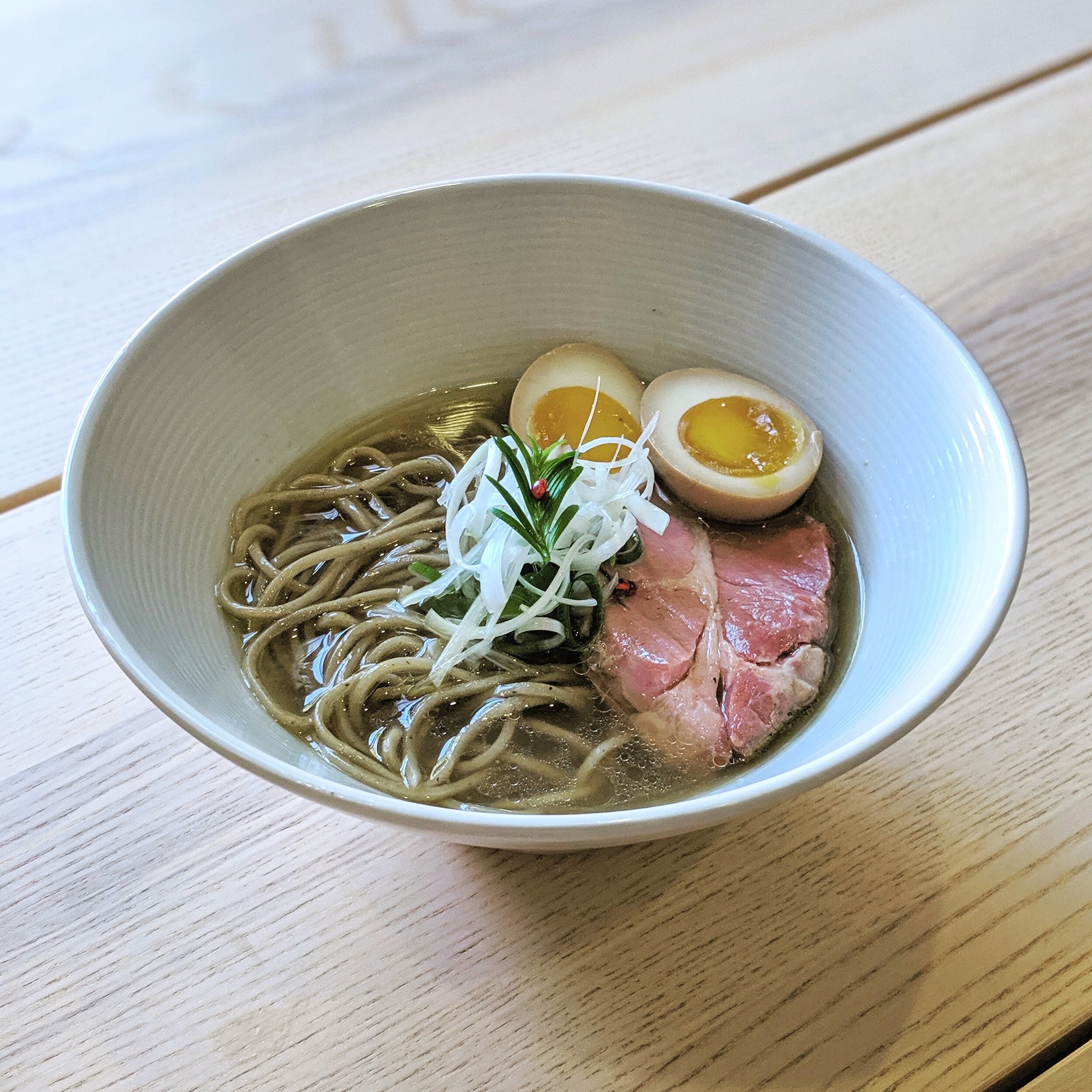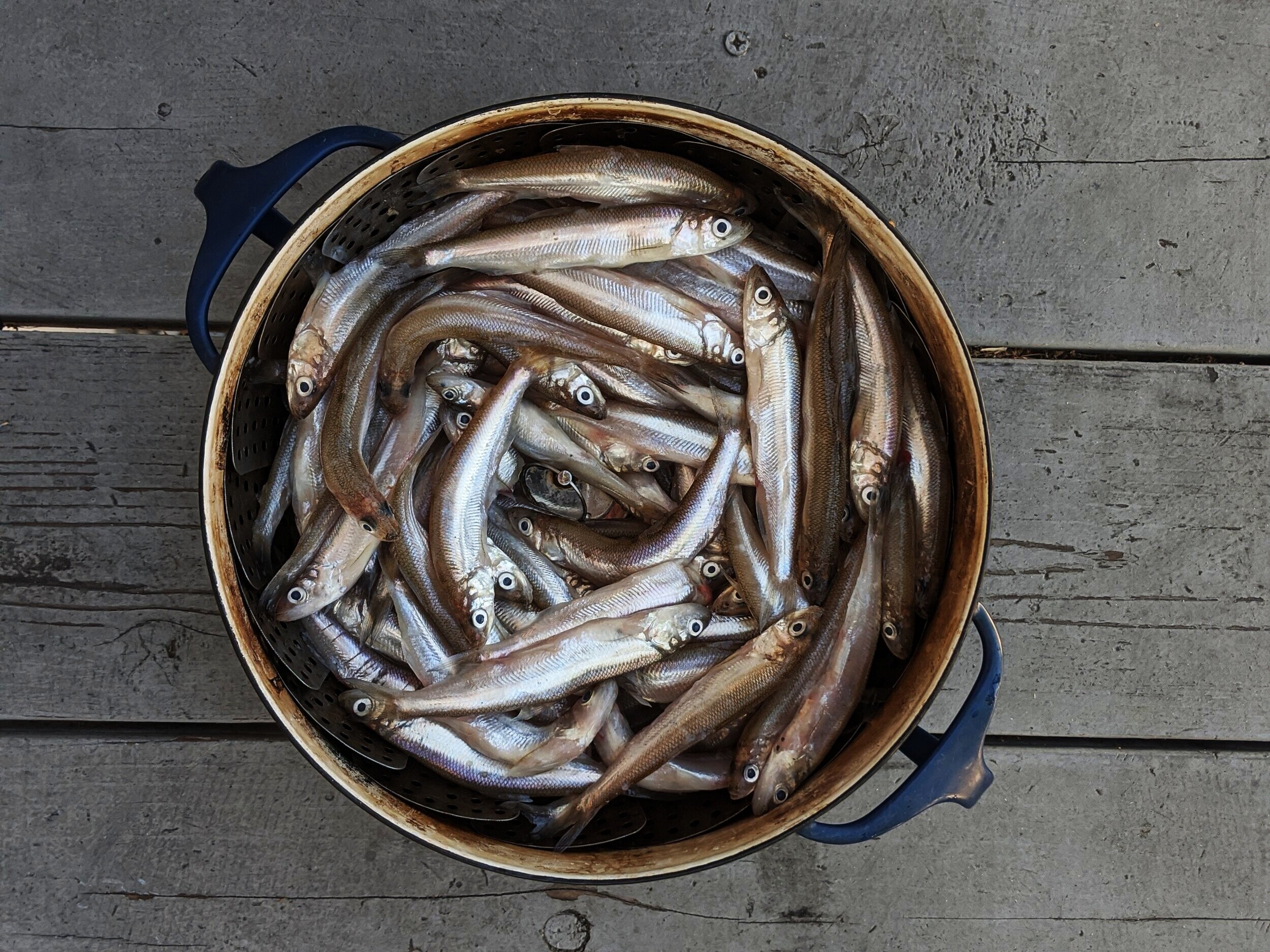Smoked Fish Dashi and Cooking Local
If the messages I’ve received since my Way of Ramen podcast visit are any indication, home ramen chefs are struggling. They want to enhance their ramen with the pungency of fish, but they can’t find niboshi — the dried sardines from Japan deemed perfect for the job.
The good news is you don’t need niboshi to make a pungent soup. And in some ways, not using niboshi can make a bowl of ramen more authentic. In this post, I share my recipe for a smoked fish dashi that doesn’t use niboshi (or a smoker). It’s meant to be an example of the benefits of embracing local food.
When food vendors in post-World War II Japan began serving ramen, they weren’t searching far and wide for their ingredients.
Instead, they were at local markets. They were in conversations with local producers and likeminded vendors. They were buying local products. Not because these products were necessarily the best for the job, but because the products and the producers shared the same ecosystem.
Farmers market visit in CDMX
In some ways, the ecosystem that surrounded ramen built ramen. Like most historical dishes composed of multiple ingredients, ramen ingredients were combined because it was convenient to combine them in that time and place. In the same way, the Neapolitan pizza was conveniently composed of the mozzarella cheese and San Marzano tomatoes readily available in Naples.
Still, despite the apparent randomness of their contribution, historically-convenient ingredients in a dish like ramen or pizza do often define the dish. As dishes persist over time, chefs perfect other aspects of recipes while keeping the convenient ingredients constant. And as those dishes get more popular, the production of those convenient ingredients becomes more refined and specialized. Eventually, it can seem (and taste) like those once-convenient ingredients are essential for the dish.
But convenience isn’t as universal as a recipe — or even as universal as a genre of food. For that reason, I advocate for stepping back. Way back. When I’m cooking, I try to put myself in the shoes of someone creating the dish for the first time. I think local.
Embracing where you are
Here, I’m trying to convince you to eat locally (and seasonally) — even when you’re making a recipe from far away. There are a few advantages to doing so:
History: It’s what the OGs did! This is authenticity. Unless you think FedEx-ing your ingredients is authentic.
Evolution: If you’re good at it, you can unlock new, better flavors that even those OGs might have envied.
Creativity: This is your chance to express the purity of your region in ways that no one has before.
Cost: Often, buying local is less expensive than shipping some odd ingredient.
Flavor: Flexing this skill will help you capture what’s in season, too. Harnessing seasonality is what separates the best from the rest.
Support: When you buy local, you’re supporting your own ecosystem and contributing to others who are doing the same. There’s a snowball effect wherein cities become culinary industrial clusters and really shine.
To embrace local is a simple philosophy, but it’s responsible for some of the all-time greats. It’s how Jeremiah Tower put Chez Panisse on the map (he dared to make dover sole with petrale!). It’s how Rene Redzepi and Noma unearthed culinary creativity never before seen (they dared to create gourmet recipes with foraged Danish produce).
This is why the American sea buckthorn-weilding Noma wanna-bes totally miss the point. Sea buckthorn from Denmark isn’t Noma; the approach is Noma. From my perspective, the same mantra applies to classic dishes like ramen, too.
How to embrace the time and place
Redwood tips ready to forage
When cooking, I’m always trying to embrace the current time and place. Here are some tips for doing so effectively.
Research what makes your time and place special. Know what is in season. Know what you can buy (or forage!) where you are that you can’t buy elsewhere. What would make other chefs in other seasons from others cities jealous?
Show up to the market without a plan. Shopping lists are inevitably less reflective of your market than your market is. This is especially true when buying fish (where freshness is also about the time of catch). Buy what looks great — even if it doesn’t perfectly align with what you first intended.
When executing a recipe, ask why. It’s helpful to have eaten the genre of food that you are replicating so you can understand the purpose that a given ingredient serves. Why is there niboshi? What else achieves that same goal?
Get to know your local producers and suppliers. They can make hyper-specific recommendations, so take advantage of it. Eventually, they’ll even save ingredients for you.
Night smelt ready to be smoked
I’m in San Francisco, which is one of the best major cities in the world for fresh produce. It also has a vibrant farmers market scene. Aside from the regular free-styled dinner, here are a few examples of explicitly-local dishes I’ve made:
Smoked night smelt ramen. Night smelt is caught with nets on the shore by local fishers. The fish only swim to shore when hungry, so there's nothing in their stomachs. This allows you to cook them without cutting them, which can’t be said about sardines.
Redwood tip ceviche. In the spring, the redwoods have young growth that is soft, edible and packed with citric acid. It’s a pop of vegetal acidity unlike anything else.
Lonza pizza: My friend Dario owns a deli, and he let me sample some lonza (salumi made from whole pork loin). Lonza isn’t on many pizza menus, but then again Dario isn’t friends with many pizza chefs.
This is a skill that you develop over time. But in the process, you learn more about your city. You learn to love your city. My love for San Francisco is so much stronger than it ever was, and that’s in part to the fun I’ve had learning (and failing!) to incorporate local ingredients.
Smoked Fish Dashi Recipe
To illustrate how you can develop a love for local, I’d like to introduce a smoked fish dashi recipe that can solve the woes of all you ramen chefs without niboshi. I learned about this technique while staging at Slurp Ramen Joint in Copenhagen. Slurp Ramen Joint was established in a city with near-zero Japanese restaurants and very few suppliers of Japanese ingredients. Needless to say, you couldn’t buy niboshi at the corner store.
I’ve tried many local fish for this recipe!
But Copenhagen is a seafood mecca. Buying fresh, young sardines is straightforward. And smoking them in-house is kinda fun! So Slurp Ramen Joint would smoke their own sardines and add them to a seafood-based ramen broth.
This recipe is not Slurp Ramen Joint’s recipe. First, it’s a dashi rather than an entire seafood broth (though I do incorporate it with another seafood dashi for my shio ramen). Second, it’s a template for you to be local — to replace the sardines with ingredients that are fresh, easy to acquire, and effective at adding pungency to your dashi. Let’s get to it.
Ingredients
This recipe makes about 1.5 liters of dashi.
1.8 liters water
500g local fish (oily fish preferred [e.g. sardines, mackerel, smelt, herring, or anchovies])
30g kombu (or local seaweed)
30g shiitake or porcini mushroom (or local dried mushroom)
30g bonito flakes (thicker preferred, but you’ll need to go to a store like Nijiya for that)
Instructions: Smoking the fish
I don’t have a smoker. You don’t need one for this recipe. Here’s what I do instead. Once you smoke the fish, you can store them in the freezer for months, so feel free to make more than you need.
Gut the fish (i.e. remove the insides of the fish with your fingers or a knife), then soak the fish in cold water for one hour to clean the fish of blood.
Line the bottom of a cheap dutch oven or pot with a lid with aluminum foil. Place a handful of wood chips on the foil.
Wrap the lid of the dutch oven or pot with aluminum foil (to further prevent smoke from escaping).
Dry the fish thoroughly (e.g. with a paper towel), then put the fish (heads and all) on a steamer basket. The drying is to prevent excessive moisture (and steam) that will cook your fish too much before they take on the smoke.
With the dutch oven or pot on a stove on very low heat, ignite the wood chips with a blowtorch, then put the steamer basket with fish on top of the lit wood chips. Close the lid.
Smoke the fish for an hour, or until they become amber brown and pretty dry. There should be a trickle of smoke coming out of the pot, so keep that oven exhaust fan on. I recommend opening the dutch oven every 15 minutes to ensure the wood chips are still smoking.
Instructions: Making the Dashi
Cut slits in the kombu to increase surface area. It is easier to remove the kombu later when it is a single piece, so I recommend cutting the kombu to look like a comb.
Add the kombu and mushrooms to the water for at least an hour (preferably overnight). Keep in the fridge.
Cook the water, kombu, and mushrooms for one hour at 140ºf. For extra precision while cooking, I do this sous vide in a ziploc bag.
Remove the kombu, add the smoked fish, and increase the temperature to 176ºf. Once at 176ºf, cook for 40 minutes.
Strain, then pour the contents of the bag into a pot and add 30g bonito flakes. Let the katsuobushi soak for just 60 seconds and then strain with a fine strainer. I recommend doing this part as close as possible to when you serve the dashi.




